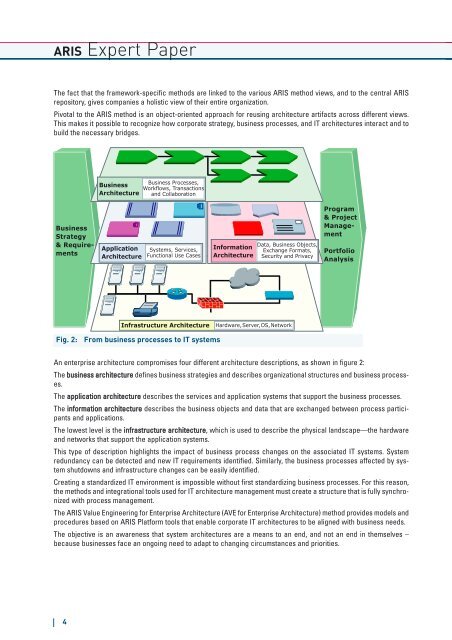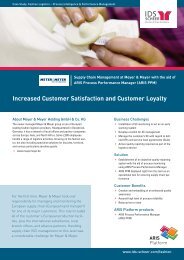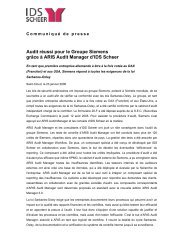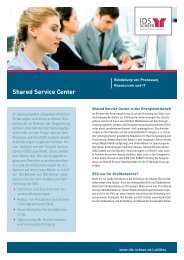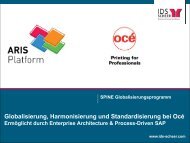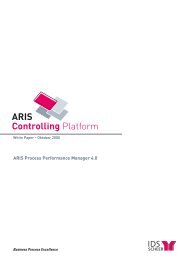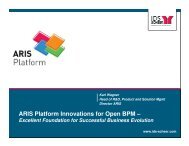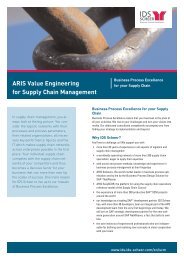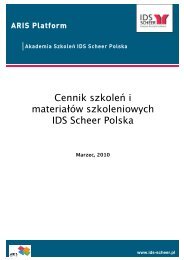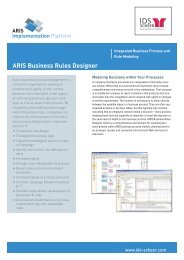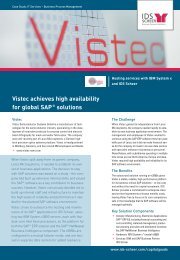From Business Process Design to Enterprise ... - IDS Scheer AG
From Business Process Design to Enterprise ... - IDS Scheer AG
From Business Process Design to Enterprise ... - IDS Scheer AG
You also want an ePaper? Increase the reach of your titles
YUMPU automatically turns print PDFs into web optimized ePapers that Google loves.
ARIS Expert Paper<br />
The fact that the framework-specific methods are linked <strong>to</strong> the various ARIS method views, and <strong>to</strong> the central ARIS<br />
reposi<strong>to</strong>ry, gives companies a holistic view of their entire organization.<br />
Pivotal <strong>to</strong> the ARIS method is an object-oriented approach for reusing architecture artifacts across different views.<br />
This makes it possible <strong>to</strong> recognize how corporate strategy, business processes, and IT architectures interact and <strong>to</strong><br />
build the necessary bridges.<br />
<strong>Business</strong><br />
Strategy<br />
& Requirements<br />
An enterprise architecture compromises four different architecture descriptions, as shown in figure 2:<br />
The business architecture defines business strategies and describes organizational structures and business processes.<br />
The application architecture describes the services and application systems that support the business processes.<br />
The information architecture describes the business objects and data that are exchanged between process participants<br />
and applications.<br />
The lowest level is the infra structure architecture, which is used <strong>to</strong> describe the physical landscape—the hardware<br />
and networks that support the application systems.<br />
This type of description highlights the impact of business process changes on the associated IT systems. System<br />
redundancy can be detected and new IT requirements identified. Similarly, the business processes affected by system<br />
shutdowns and infrastructure changes can be easily identified.<br />
Creating a standardized IT environment is impossible without first standardizing business processes. For this reason,<br />
the methods and integrational <strong>to</strong>ols used for IT architecture management must create a structure that is fully synchronized<br />
with process management.<br />
The ARIS Value Engineering for <strong>Enterprise</strong> Archi tec ture (AVE for Enter prise Architecture) method provides models and<br />
procedures based on ARIS Platform <strong>to</strong>ols that enable corporate IT architectures <strong>to</strong> be aligned with business needs.<br />
The objective is an awareness that system architectures are a means <strong>to</strong> an end, and not an end in themselves –<br />
because businesses face an ongoing need <strong>to</strong> adapt <strong>to</strong> changing circumstances and priorities.<br />
4<br />
<strong>Business</strong><br />
Architecture<br />
Application<br />
Architecture<br />
<strong>Business</strong> <strong>Process</strong>es,<br />
Workflows, Transactions<br />
and Collaboration<br />
Systems, Services,<br />
Functional Use Cases<br />
Infrastructure Architecture<br />
Fig. 2: <strong>From</strong> business processes <strong>to</strong> IT systems<br />
Information<br />
Architecture<br />
Data, <strong>Business</strong> Objects,<br />
Exchange Formats,<br />
Security and Privacy<br />
Hardware,Server,OS,Network<br />
Program<br />
& Project<br />
Management<br />
Portfolio<br />
Analysis


